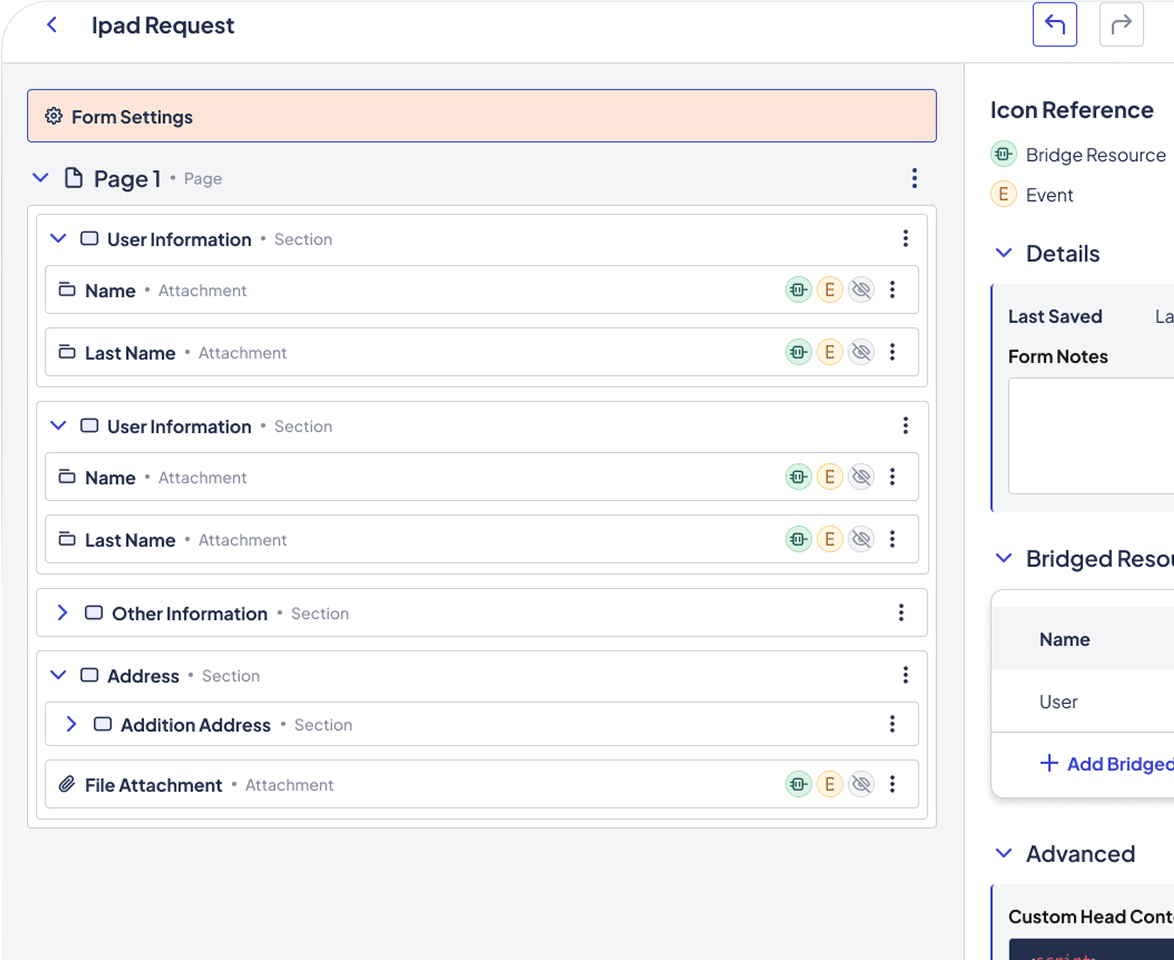Build custom. Buy traditional BPM. Adopt low-code. Enhance existing platforms. Each path promises transformation—each brings distinct risks most organizations discover too late.
Kinetic eliminates risk through architectural decisions traditional approaches can't match. Sixty-day deployments. Seventy to eighty-five percent adoption rates. Consumption pricing that aligns costs to value. The result? Organizations achieve 250-300% ROI within 18 months because we removed the structural factors that make automation initiatives fail.
How We Compare
There's More Than One Way to Solve Your BPM Challenge... But Only One Right Way
Your tools. Your speed. Our framework.
60 days
Time to first live workflow vs. 6-12 months traditional
70-85%
Adoption rates vs. 30-40% industry average
250-300%
ROI within 18 months across customers
Understanding Your Options (And Their Hidden Costs)
Every approach to business process automation solves real problems. Each also creates predictable failure modes.
Traditional BPM platforms offer comprehensive capabilities wrapped in twelve to eighteen-month implementations. Custom builds provide perfect fit initially, then consume development resources maintaining what should be commodity infrastructure. Low-code platforms accelerate deployment while creating vendor lock-in and seat-based cost escalation. Enhancement strategies improve user experience but inherit platform limitations.
Kinetic delivers BPM outcomes—orchestration, automation, unified experiences—without BPM complexity. We're purpose-built to eliminate the structural risk factors that make traditional approaches fail, regardless of category.
Explore how Kinetic compares across solution types below.
How Kinetic Compares Across Solution Categories
Traditional BPM Platforms
Comprehensive automation suites promising end-to-end process management through feature-rich platforms that typically demand extensive implementation timelines, certified consultants, and ongoing professional services.
Why Organizations Consider Them:
Mature capabilities. Established vendors. Comprehensive features covering case management, decisioning engines, and process orchestration.
The Hidden Costs:
Twelve to eighteen-month implementations before first value. Consultant dependency for modifications. Per-user licensing that penalizes scale. Proprietary architectures that resist customization. Adoption rates stalling at 30-40% because interfaces prioritize functionality over experience.
How Kinetic Differs:
We deliver BPM outcomes—orchestration, automation, visibility—without BPM complexity. Sixty-day deployments. Business-user-friendly workflow builders. Consumption pricing that aligns costs to value. Modern interfaces users actually want to adopt. Orchestration across existing systems rather than forcing replacement.
Workflow Engines & Backend Orchestration
Developer-centric process engines built on BPMN standards, excelling at backend orchestration while leaving user experience layers for organizations to build separately.
Why Organizations Consider Them:
Powerful backend orchestration. Open-source options available. Developer control over process logic. Standards-based approach (BPMN 2.0).
The Hidden Costs:
No native user experience layer—you build all portals, forms, and interfaces. Human-in-the-loop tasks require custom UI development. Integration frameworks exist but connectors must be coded. Business users remain dependent on developers for all changes. Adoption suffers when backend excellence doesn't translate to frontend usability.
How Kinetic Differs:
We deliver complete solutions—powerful orchestration AND the experience layer. Pre-built portal frameworks, form builders, approval routing, and notification systems come standard. Business users modify workflows without coding. Your team gains both backend power and frontend polish, reducing implementation timelines while improving adoption.
Enterprise Platform Enhancement
Strategies that preserve existing enterprise system investments (ServiceNow, Salesforce, MuleSoft) while adding modern experience layers and cross-system orchestration capabilities.
Why Organizations Consider Them:
Protects existing platform investments. Avoids rip-and-replace disruption. Extends value without buying additional modules. Improves employee experience without retraining on new systems.
The Hidden Costs:
This isn't a comparison—it's a complement. Kinetic enhances enterprise platforms rather than replacing them. ServiceNow remains your ITSM system of record while Kinetic provides unified employee portals. Salesforce manages customer data while Kinetic orchestrates cross-system processes. MuleSoft handles backend integrations while Kinetic delivers frontend experiences.
Organizations choose Kinetic PLUS their enterprise platforms, not VERSUS them. We extend their value through modern experiences and cross-system workflows without forcing migration or additional module purchases.
.
How Kinetic Differs:
We deliver complete solutions—powerful orchestration AND the experience layer. Pre-built portal frameworks, form builders, approval routing, and notification systems come standard. Business users modify workflows without coding. Your team gains both backend power and frontend polish, reducing implementation timelines while improving adoption.
Low-Code Development Platforms
Visual development environments promising rapid application delivery through drag-and-drop interfaces, pre-built components, and citizen developer empowerment.
Why Organizations Consider Them:
Faster than traditional development. Lower barrier to entry. Promises of business user empowerment without deep technical skills.
The Hidden Costs:
Vendor-controlled user interfaces that limit customization. Per-user pricing models that create cost escalation as adoption grows. Platform lock-in where applications become difficult to migrate. Governance challenges when business users build without IT oversight. Scalability limitations once you exceed platform guardrails.
How Kinetic Differs:
We combine low-code workflow building with headless architecture. Business users build process logic through visual tools while developers control experience layer using modern frameworks—React, Angular, Vue. Consumption pricing eliminates seat-based penalties. API-first design prevents lock-in. Enterprise-grade governance from day one, not retrofitted later.
Custom-Built Solutions
In-house developed automation built by internal teams or contractors, providing maximum control and customization at the cost of ongoing maintenance burden.
Why Organizations Consider Them:
Complete control over features and architecture. No licensing fees. Perfect fit for unique requirements. Developer preference for ownership.
The Hidden Costs:
Six to eighteen months before production deployment. Ongoing maintenance consuming development capacity. Technical debt accumulating as frameworks age. "Bus factor" vulnerability when key developers leave. Scalability challenges requiring architectural redesign. Opportunity cost of building infrastructure instead of business differentiation.
How Kinetic Differs:
We provide 80% of what you'd build custom, out-of-the-box, so your developers focus on the 20% that's truly unique to your organization. Pre-built portal frameworks, form builders, workflow engines, and integration patterns that would take months to develop. Your team builds business logic, not infrastructure. Time-to-value measured in weeks, not quarters.
The Common Thread: Kinetic Eliminates Risk Across All Categories
Different solution categories create different failure modes. Traditional BPM brings complexity. Custom builds consume maintenance capacity. Low-code creates vendor lock-in. Backend engines lack experience layers. But one pattern persists: structural risk factors that organizations discover too late.
Kinetic's architecture eliminates these factors through four fundamental design decisions:
Experience First
Start with how people work, not how systems want to work. Seventy to eighty-five percent adoption rates prove intuitive design reduces risk more effectively than change management programs ever could.
Orchestration Over Replacement
Connect existing systems rather than replacing them. USDA integrated Active Directory, CMDB, vSphere, and Azure without forcing consolidation. DISA processes over $4B in annual equipment orders across multiple backend systems. Reduced technical risk, shorter timelines, lower organizational disruption.
Consumption Economics
Align costs to value delivered, not capacity purchased. Organizations achieve 40-60% lower TCO versus traditional BPM while eliminating seat-based penalties that punish success. Broad deployment becomes financially viable because adoption doesn't trigger budget anxiety.
Incremental Delivery
Prove value in 60 days rather than waiting 6-12 months. GreenState Credit Union, USDA, and DISA all deployed first workflows faster than traditional vendors complete discovery phases. Early wins fund expansion rather than requiring sustained faith through lengthy implementations.
Which Comparison Matters Most to You?
(Pega, Appian, IBM), focus on implementation timelines, consultant dependency, and adoption rates. The question isn't whether they're powerful—they are. The question is whether that power justifies twelve-month implementations and interfaces only consultants love.
Examine total cost of ownership once you factor in per-user licensing across broad deployments. Calculate what 1,000 users costs annually, then multiply by industry-average 30-40% adoption rates. You're funding seats that sit empty while adoption remains theoretical.
Quantify ongoing maintenance burden and opportunity cost. Your developers could build what Kinetic provides—but should they? Or should they focus on capabilities that actually differentiate your organization?
Assess how much development effort goes toward building experience layers, approval routing, and user interfaces that should be commodity infrastructure. Backend excellence matters less when frontend usability suffers.
Recognize that Kinetic works WITH your investments, not against them. ServiceNow, Salesforce, and other platforms remain authoritative for their domains while Kinetic provides unified experiences and cross-system orchestration.
Real Organizations. Real Outcomes. Real Risk Reduction.

Rich Barr
Automation Lead
“We've been using the Kinetic Data Platform for nearly 10 years and our business could not run without it. [...] We were able to take our server provisioning process from 3 weeks to 30 minutes using workflow automation and integration. Given all of this and more we are able to automate more than 75% of our business and service functions allowing great self-service products to our customers.”

Administrator
Enterprise Government
“Ever since we adapted Kinetic Data tools five years ago, our organization has grown in size, but the automation team has stayed the same. That tells a lot about a product's reliability, productivity and its adaptability. [...] This has greatly reduced time and human cost across government agencies. Since successful launch of [the] product, we have fulfilled over 80,000 service requests in the organization.”

Maciej Naumienko
System Manager
“The Kinetic Platform transformed how our 19,000 employees access and request equipment across the organization. Instead of managing multiple disconnected systems, we now have one flexible portal that integrates everything seamlessly. The ability to automate workflows while maintaining a consistent user experience has been a game-changer for both our IT team and our employees.”
Stop Comparing Features. Start Eliminating Risk.
The solution category matters less than the outcome. Whether you're evaluating traditional BPM, considering custom builds, exploring low-code platforms, or enhancing existing enterprise systems, one question persists: will this initiative join the 70% that fail to deliver intended value?
Kinetic eliminates the structural factors that create risk across every category. We deploy faster than traditional BPM. We cost less than custom builds once you factor in maintenance. We offer more flexibility than low-code platforms. We provide complete solutions beyond what workflow engines deliver. We enhance enterprise platforms rather than replacing them.
Different paths. Same destination: business value delivered with reduced risk.
